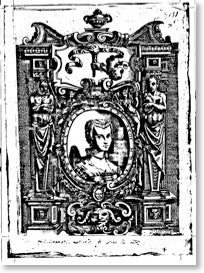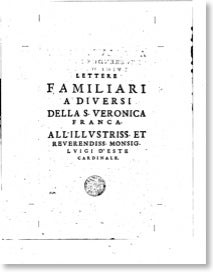Poems

Veronica Franco’s poems consist of 25 capitoli in terza rima, a poetic form used by Dante in The Divine Comedy. This meter and rhyme scheme consists of eleven-syllable lines arranged in interlocking tercets (aba, bcb, cdc). The length of the capitol is variable: the shortest is 39 lines long, the longest 565. The collection of poems can be divided into two parts. The first contains fourteen poems arranged in pairs, written by men as well as by Franco. One capitolo is followed by a response by the other poet.
Capitolo 1 was composed by Marco Venier, the nephew of Domenico Venier, whose name appears at the head of the poem in one of the original copies of the book but is replaced with incerto autore (unknown author) in other copies. This pattern changes from Capitolo 15 to Capitolo 25. The authors of the other poems in men’s voices are not identified. In these pairs of poems, the first writer sets a theme and the second responds to it. This pattern of poems paired in dialogue changes in the second part of the collection. From Capitolo 15 on, all poems are by Franco. She continues to address her eleven final capitoli to male readers, but she also includes more meditative, elegiac poems—laments over love or separation from her city—and she ends the collection with a long capitolo dedicated to a Veronese churchman, Marcantonio delle Torre, in praise of his country estate.
Two groups of poems tell a story that spans both sections of the collection. A trio of Franco’s poems (3, 17, 20) deals with jealousy and separation in terms clearly drawn from ancient Roman elegy. And two poems crucial to her defense of herself and of women in general against a male attacker begin in the first section (13) and continue into the second (16). By far the most serious critique of poetry in which Franco engaged, however, was her debate with Maffio Venier (1550-86), which led to defend herself but her sex in general against mockery and hatred from men. Sometime in the 1570s, Maffio circulated in manuscript three poems in Venetian dialect, specifically targeting Franco. Maffio was attacking not only Franco but the men who had written poems praising her. It may well be that Franco saw this attack on male poets as well as herself as a justification for asking advice, in Capitolo 23, from a man expert in the language of dueling, possibly Domenico Venier, as she prepared to respond to her enemy. Franco was not certain at first of the identity of the man who had written against her. So in Capitolo 13 she reproaches a lover (Marco Venier) for mistreating her in an unexpected betrayal and for turning on her with lies. Finally, one of her letters confirms that she has confused him with the author of the satirical verses against her.
In Letter 47 she apologizes to a man; she now sees, she says, that the poems written against her were not good enough to have come from his pen, and she explains that she sent her response to him under the mistaken impression that he had been the author of these insults. It is in her Capitolo 16 that she focuses her counterattack against Maffio Venier, once the confusion has been cleared up. She sets out to expose him, his inept sonnet, and his hostility to women. Here, as in Capitolo 13, she adopts the vocabulary of dueling—more precisely, chivalrous warfare. Franco’s verve and eloquence in this poem and in Capitolo 16 are most evident when she declares that she represents what all women are potentially able to do in a display of feminine competence. In other capitolo, too, she looks sympathetically at the situation of women (22, 24) and defends them against male attackers. She imagines not a world in which women live without men but one in which they can coexist in safe reciprocity with men.
Letters

Franco’s Lettere familiari a diversi use literary form to shape a representation of the courtesan’s life for a public audience. She refers to the style of the familiar letter in Letter 37 in which she says she will use the laconic rather than the Asiatic style which means that she will employ the brevity and plain speech of Cicero’s letters rather than the highly stylized, intricate prose style of certain orators. The letters have biographical value; they show her in a variety of daily activities—playing music, sitting for a portrait, organizing a dinner party (Letters 9, 21, 13), requesting the loan of a wheelchair after a domestic accident (44). She writes as a mother on two occasions, congratulating a noblewoman on the birth of her son (16) and apologizing for not writing to a friend because her own sons have been sick with smallpox (39). The letters also comment on events and situations represented in the poems; reading the two together, then, is highly informative.
But at the same time, these letters inform us about Franco’s public literary activities and the image she wished to project. She sends letters to her literary advisor, Domenico Venier, for help in revising her poem; in a letter to a fellow Venetian and to the painter Tintoretto (17, 21) she declares her enthusiasm for the intellectual discussions that occur in the “academies of talented men.” And in her longer letters she writes as a moralist, giving advice to a patrician male friend (4, 17) and to a woman friend who is thinking of making her daughter into a courtesan 922). As in her poems, she adopts a position of public authority that calls attention to her education, her rhetorical skill, and the solidarity she feels with women.
The familiar letter genre permitted Franco to shift private life into the public sphere; it also permitted her to comment in print on the behavior of men. She positioned herself as a judge and advisor, writing as a courtesan-secretary to those individuals who had been led astray. Given that the standard accusation against the courtesan was that she led a chaotic, dissolute life, the familiar letter made it possible for Franco to turn the tables in a kind of moral one-upmanship. Finally, in contrast with the polemical mode of the capitolo, the familiar letter established the appearance of intimacy and equality between writer and recipient at the same time that it requires a grasp of the proper rhetorical forms advocated by classical authors.
You will find images of Franco’s sonnets to King Henry III of France by clicking on the links below:
Sonnet 1
Sonnet 2
![]()